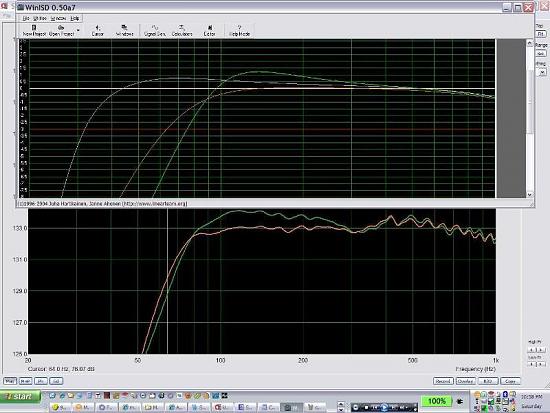I've been trying to get to this project since last Christmas, but somehow life got in the way. Today I finally got far enough along that I thought I would share some interesting observations on capacitor loading a woofer in a small box. My goal here is a small bookshelf sized speaker with bass that doesn't require a subwoofer. If you have been considering using this technique, you might find this interesting.
My test box (which I assume will eventually be a real finished box at some point) is a small, sealed 3/8 cu.ft. In it, I put a moderately priced 8" woofer. Normally, a woofer this size in a box this small would not be recommended because the Q gets rather high. Indeed, I get a Q of about 1.0 with the box fully stuffed. This is actually not too bad since it results in a bass hump of only about 1.5 db and its listenable as is, but still not ideal.
Here are the modeled and ACTUAL close mic'ed measured response:

Sorry about the picture quality. The top window is WinISD modeling of the woofer in various sized boxes. The line that extends farthest into the bass region is a rather large 2.5 cu.ft. ported box. Not bad, but 2.5 cu.ft. is not a bookshelf speaker. Next, the top line at 150 hz is the same woofer in 3/8 cu.ft. stuffed and sealed. Finally, the lower line is the woofer in a 1.0 cu.ft. stuffed and sealed box which yields a Q of about .75. But even 1.0 cu.ft. is a bit much for a bookshelf speaker.
Now look at the bottom gragh. This is the actual ARTA measured response in 3/8 cu.ft. stuffed and sealed. The top graph has no capacitive loading. The lower graph has 500 uF in series with the woofer. I stretched both the WinISD and ARTA graphs so that they are the same scale on both the frequency and SPL axises for direct comparison. Notice the SPL scale is just 2db per division in the ARTA graph so the roll off is not quite as sharp as it looks. Pretty amazing match to the WinISD model, isn't it.
The cap loading does flatten out the response very well and it extends the bass response a little as well. Frankly, I was hoping for more bass extension using this technique, but if you compare it to the modeled 1.0 cu.ft. sealed box, its almost identical down to 60 hz. I guess this isn't too bad after all. You get the response of a 1.0 cu.ft box in a .375 cu.ft. box.
I'll reveal more details as I get further along, but for now, I just wanted to show the effects of capacitor loading a woofer in a smaller than optimal box. It works well, but you can't expect the bass extension miracles that some have suggested for this trick. Its good for a project like this, but I'm not so sure it would help a sub that much.
-Bob
My test box (which I assume will eventually be a real finished box at some point) is a small, sealed 3/8 cu.ft. In it, I put a moderately priced 8" woofer. Normally, a woofer this size in a box this small would not be recommended because the Q gets rather high. Indeed, I get a Q of about 1.0 with the box fully stuffed. This is actually not too bad since it results in a bass hump of only about 1.5 db and its listenable as is, but still not ideal.
Here are the modeled and ACTUAL close mic'ed measured response:
Sorry about the picture quality. The top window is WinISD modeling of the woofer in various sized boxes. The line that extends farthest into the bass region is a rather large 2.5 cu.ft. ported box. Not bad, but 2.5 cu.ft. is not a bookshelf speaker. Next, the top line at 150 hz is the same woofer in 3/8 cu.ft. stuffed and sealed. Finally, the lower line is the woofer in a 1.0 cu.ft. stuffed and sealed box which yields a Q of about .75. But even 1.0 cu.ft. is a bit much for a bookshelf speaker.
Now look at the bottom gragh. This is the actual ARTA measured response in 3/8 cu.ft. stuffed and sealed. The top graph has no capacitive loading. The lower graph has 500 uF in series with the woofer. I stretched both the WinISD and ARTA graphs so that they are the same scale on both the frequency and SPL axises for direct comparison. Notice the SPL scale is just 2db per division in the ARTA graph so the roll off is not quite as sharp as it looks. Pretty amazing match to the WinISD model, isn't it.
The cap loading does flatten out the response very well and it extends the bass response a little as well. Frankly, I was hoping for more bass extension using this technique, but if you compare it to the modeled 1.0 cu.ft. sealed box, its almost identical down to 60 hz. I guess this isn't too bad after all. You get the response of a 1.0 cu.ft box in a .375 cu.ft. box.
I'll reveal more details as I get further along, but for now, I just wanted to show the effects of capacitor loading a woofer in a smaller than optimal box. It works well, but you can't expect the bass extension miracles that some have suggested for this trick. Its good for a project like this, but I'm not so sure it would help a sub that much.
-Bob


Comment